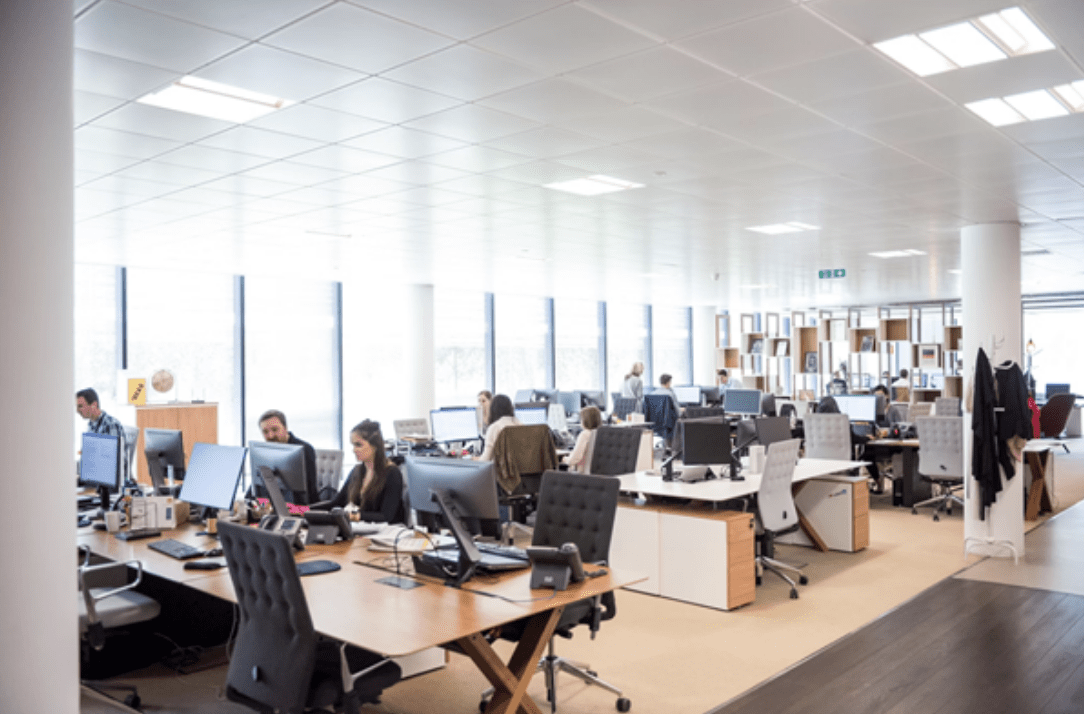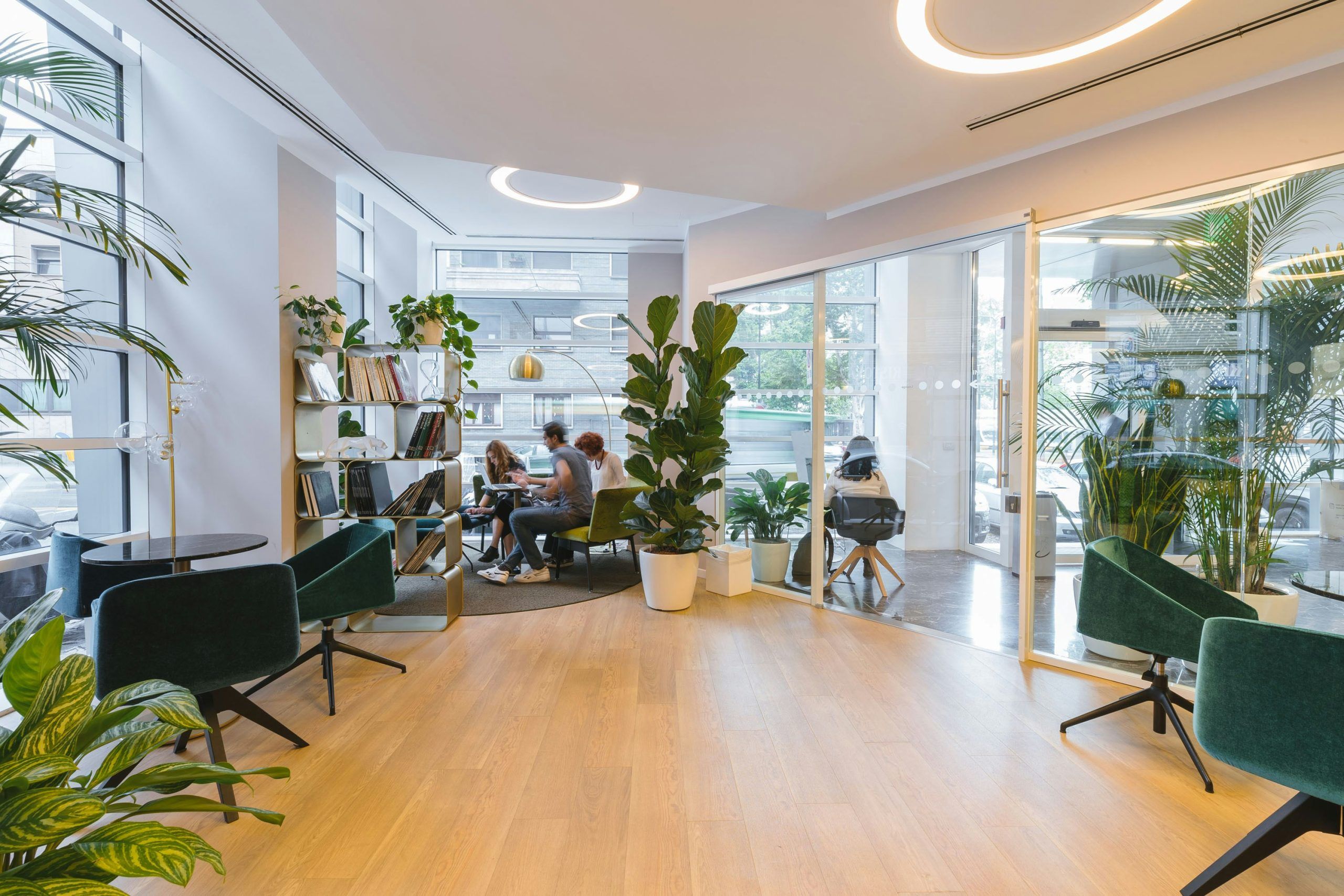Offices are dynamic environments where creativity and efficiency converge, making them crucial for the productivity of white-collar professionals. The workspace can take up an entire building, a floor, a room, or a desk in a small/home office. When designing office spaces, architects and interior designers rely on floor planning software to arrange furniture and equipment efficiently

Getting Started with Floor Layout Apps
In designing office spaces, a floor plan is a drawing to scale, depicting a view from above. Floor plans show the relations between rooms, spaces and office features at one level.
Floor plans can show the structure of office space with:
- walls, windows and doors with opening direction, stairs and elevators
- notes indicating room and area functions
- reception and hall
- wardrobe room
- open office area
- meeting room
- boss area
- kitchen and dining room
- fitness and relax spaces
- toilets and washrooms
- computer network server room
- technical room
- storage room, etc.
- notes to specify finishes and construction techniques
- electric wiring, boards and sockets
- lighting, switches and electrical devices
- piping and plumbing
- HVAC plan
- telecommunication and computer network
- office furniture and equipment
- emergency exits and evacuation routes
- security and fire safety systems.
To design your basic floor plan:
- Measure your workplace.
- Choose scale for your floor plan.
- Draw walls.
- Add fixed features (columns, niches, shafts, stairs).
- Add windows and doors.
- Add dimensions, room labels and annotations.
Then you can use your basic floor plan and vector stencils to draw the layout of furniture and appliances, lighting, telecommunication and computer network, utilities, etc.
Advanced Design Strategies
Advanced interior design strategies, such as using AI to simulate different layouts, help in selecting the most functional and aesthetically pleasing location for each element. AI applications make it easier to model office projects. Architectural 3D modeling tools are useful for assessing various office designs.
Take advantage of expert help and best practices when deciding which office design you will implement.
- Determine the purpose of rooms and spaces and who will use them.
- Identify workplaces to place in the rooms.
- Consider environmentally friendly office design and employee well-being.
- Before buying furniture and appliances, create few arrangements to choose the best layout. Interior design tools with the AI speed up the drawing of furniture layouts.
- Consider the selected office furniture and equipment layout when arranging lighting fixtures, switches, outlets, HVAC systems, computer networking, telecommunications cabling, CCTV cameras, security and fire safety systems, piping and plumbing.
- Establish the specifications for commercial toilet dimensions to ensure compliance with local building codes and accessibility standards.
Now you are ready to plan construction work, purchase and install office furniture and equipment.
Tools and Tips for Effective Use
The office design tools commonly used by architects, civil engineers and interior designers are powerful, complex and expensive architectural CAD systems and interior 3D modeling and animation suits.
For occasional office floor planning, homeowners, realtors, office workers, and small businesses often use easy-to-use and less expensive floor layout app. For example, see Microsoft Visio and ConceptDraw DIAGRAM.
Sustainability and Well-being
In the context of office design we mean:
- office sustainability as an environmentally friendly business activity in the work space, and
- employee well-being as a mentally and physically healthy environment for office work.
Eco-Friendly Office Design
The sustainable office design minimizes the harm to the environment by green building and design technologies:
- green buildings
- energy and water saving
- natural and energy-efficient lighting
- energy-efficient HVAC systems
- sustainable materials and renewable energy sources
- recycling and repurposing, etc.
Promoting Employee Well-being
Workplace or corporate wellness programs to support employee mental and physical health often include:
- office fitness facility and flex-time for exercise
- office relaxation, yoga and meditation area, vision-boards
- nap room with sleep pods
- office greenery
- office kitchen and dining hall
- “walk and talk” meetings
- health education and medical screening
- weight management, healthy food in vending machines
- smoking cessation program
- financial and social incentives for healthy behavior.
The Office of the Future: Predictions and Emerging Trends
Envisioning the office of the future involves integrating cutting-edge design concepts like paperless operations, open layouts, and co-working spaces, heralding a new era of workplace innovation. Current Concepts: Paperless Office, Open Office Layout, Office Partitions, Co-working, Flexible Workspace, Hot Desk, Virtual Workplace, Small/Home Office.
Innovations in Floor Layout Technology
The latest innovation in office design software is the use of artificial intelligence (AI) to create a floor plan. Architectural AI technology is still in the experimental stage, but it is useful for quickly generating office layout options based on inputs and a company’s design preferences.
In conclusion

The floor planners allow you to create office layouts for furniture, appliances, lighting, computer networks, telecommunication wiring, electrical outlets and switches, HVAC and climate control, utilities, security and fire safety systems. Use modern office design tools to organize eco-friendly workspace for employee well-being and high productivity.

